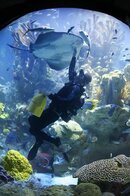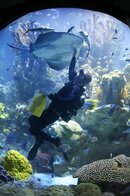...
As a DSO, I am responsible for more than a hundred divers - people who come to me already "certified", but who I have to make sure are truly competent divers, or its my responsibility to either help them become competent or wash them out. I'm saying this because the mask on forehead question is one I always ask during my checkout dive process. I tell them that if they dive for my institution they can not park their mask on their forehead - ever.
...
Muscle memory.
...
Muscle memory...really?
YOUR Institution...sounds like a superior complex.
You focus so much attention on where a diver places a mask yet you post a pic on your website and use it as your avatar of yourself (I presume it is you) touching a sea turtle. Captive or wild, you are sending a message it it is alright to manhandle sea life such as protected species like the sea turtle. As an instructor and DSO I would have hoped you might have taken an environmentally sound approach of look but do not touch.






